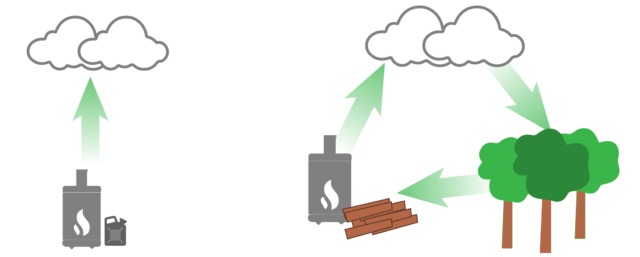Carbon neutral means the carbon released is equal to carbon sequestered. In the most basic form: Carbon Released – Carbon Sequestered = 0
This is also called achieving a net zero carbon footprint. As simple as the equation looks, carbon neutrality is not a simple task. It is becoming increasingly important for school districts to take a comprehensive and innovative approach to achieving a net zero carbon footprint, whether to meet carbon neutrality regulations (such as in BC) or reduce costs from carbon-based energy sources.
Common sources of carbon emissions
In 2014, Canada emitted 732 megatonnes of carbon dioxide equivalent. This is around 20% higher than 1990 levels, although emissions have remained around 700 megatonnes since 2000.
Carbon is released from primarily heating and transportation, meaning every industry and sector emits carbon and other greenhouse gases. In 2012, school districts in British Columbia accounted for 24% of all public sector carbon emissions. The biggest source was associated with operating and heating buildings.
Measuring current emissions to quantify carbon released
To measure Carbon Released, organizations must account for the major sources of carbon emissions, including:
- Source of heat for all buildings
- Source of electricity
- Source of fuel for vehicles
- Indirect sources (such as paper)
For BC organizations, the provincial Ministry of Environment outlines the best practices for quantifying emissions in this 2016/2017 guide.
Reducing carbon emissions
The easiest way to sequester carbon is by not emitting it. Energy efficiency, alternative fuel or energy sources and building net-zero buildings reduces your organization’s carbon footprint. This directly reduces Carbon Released.
Case Study – Biomass boiler in BC school district achieves 95% carbon neutrality
In 2016, School District 27 in British Columbia installed a biomass boiler at an elementary school facility. The 400 kW pellet boiler heats the school and two neighbouring facilities, including the Thomson Rivers University Williams Lake Campus. The new boiler is 95% carbon neutral.
Burning natural gas transfers geologic carbon into the atmosphere – it is a one-way process. The new biomass boiler burns wood pellets and carbon emissions are converted back to trees. This is a natural and relatively fast cycle.
Learn more about SD27’s biomass success story.

Fossil fuel combustion (left) transfers carbon from geologic sources to the atmosphere. Biomass combustion (right) is a natural cycle where biogenic carbon is transferred back into biomass.
Sequestering carbon with offsets
It is necessary for schools to be properly ventilated, heated and powered, and carbon neutral opportunities do not exist for all districts yet. Achieving carbon neutrality is not possible without offsets.
Accounting for offsets, the equation becomes: Carbon Released – Carbon Offsets = 0
Organizations can purchase carbon offsets (typically sold as a one tonne of carbon dioxide equivalent). Funds from offsets go to projects that have a net reduction in carbon emissions, such as forest protection projects or carbon sequestration. Of course, reducing carbon emitted means less money required to offset the carbon. Energy efficiency really does pay off.
